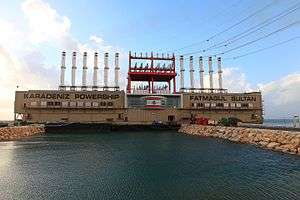MV Karadeniz Powership Fatmagül Sultan
 Karadeniz Powership Fatmagül Sultan | |
| History | |
|---|---|
| Name: | Karadeniz Powership Fatmagül Sultan |
| Owner: | Karadeniz Powership Co. |
| General characteristics | |
| Class and type: | Special Service-Floating Power Plant |
| Length: | 142.0 m (465 ft 11 in) (LOA) |
| Beam: | 42.0 m (137 ft 10 in) |
| Capacity: | 203.1 MW generation (as powership) |
The MV Karadeniz Powership Fatmagül Sultan is a Liberia-flagged powership, a floating power plant, owned and operated by the Istanbul based Turkish company Karadeniz Powership Co. Built as a barge, she was converted into a powership in 2013 at Sedef Shipyard in Tuzla, Istanbul, Turkey. She is commissioned to supply electricity to the power grid in Lebanon.
Ship
The 142.0 m (465 ft 11 in) long vessel has a beam of 42.0 m (137 ft 10 in).[1][2][3][4]
Powership
Converted into a power barge by Sedef Shipyard in Tuzla, Istanbul in 2013, she was renamed Fatmagül Sultan after the sister of Karadeniz Holding's chairperson.[3] Equipped with eleven electric generators,[5] four high-voltage transformers and operated by a crew of sixty technicians and engineers, the powership has an installed generation capacity of 203.1 MW on dual-fuel (HFO- and gas-fired).[6] The powership's fuel tanks capacity allows her to generate ten days long uninterrupted power.[4][7] She is the sixth member of a fleet capable of more than 1,500 MW.[2][3][8]
According to a power purchase agreement, worth US$370 million, signed on July 13, 2012 in Beirut with the Lebanese Government,[4][7] the powership is the first of two to supply a total of 406.2 MW electricity in Lebanon.[5] The poweship left Turkey on February 8, 2013 heading for Lebanon.[2] She arrived at her destination after one week voyage.[4][7] Following a ceremony held in Beirut in early April 2013 in presence of Gebran Bassil, Lebanese Minister of Energy and Water, the powership began to supply 188 MW electricity to the grid in Lebanon,[9] where the demand on electric power grew up more than expected from 2011 on through increased consumption and the influx of refugees of the Syrian Civil War. For a period of three years,[2] at least 15% of the country's electric power needs is generated by the powership.[8] "This makes out additional two hours' electricity a day for the power-shortages beset country" as stated by the general manager of Électricité du Liban, main Power Utility of Lebanon.[5]
References
- ↑ "2012 ELPR Vessel Listing". The Standard Club. Retrieved 2015-12-05.
- 1 2 3 4 "'Fatmagül Sultan' Beyrut'u aydınlatacak". Milliyet (in Turkish). 2013-02-09. Retrieved 2015-12-05.
- 1 2 3 "Fatmagül Sultan uğurlandı". Hürriyet (in Turkish). 2013-02-08. Retrieved 2015-12-05.
- 1 2 3 4 "Fatmagül Sultan gemisi Lübnan'da". Cumhuriyet (in Turkish). 2013-02-16. Retrieved 2015-12-05.
- 1 2 3 Tisdall, Simon (2013-04-11). "The Turkish 'power ship' keeping the lights". The Guardian. Retrieved 2015-12-05.
- ↑ "Filomuz" (in Turkish). Karadeniz Enerji. Retrieved 2015-12-05.
- 1 2 3 "Karadeniz Powership Fatmagul Sultan arrives to Lebanon". Beiruting. Retrieved 2015-12-05.
- 1 2 Baysal, Ercan (2013-04-06). "'Fatmagül Sultan' elektrik üretimine başladı". Zaman (in Turkish). Retrieved 2015-12-05.
- ↑ "Fatmagül Sultan power ship provides electricity for Lebanon". Today's Zaman. 2013-04-05. Retrieved 2015-12-05.